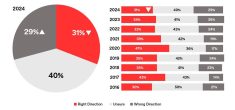The CFA is lobbying for changes to three federal income tax rules and the Agri-Invest program it says would attract badly needed investment and young people into farming, while encouraging small operations to grow.
Garnet Etsell, a member of the Tax Working Group of the Canadian Federation of Agriculture said in an interview the group is gathering data and honing its presentation for federal politicians.
The three provisions the association is targeting for change in The Income Tax Act are Section 31, which covers restricted farm losses, Section 55 (2) on deemed proceeds and Section 84.1 (1) on non-arm’s length share of sales. The group is focusing on the first two for now, said Etsell, a B.C. farmer and former CFA vice-president.
Read Also

Mazergroup’s Bob Mazer dies
Mazergroup’s Bob Mazer, who helped grow his family’s company into a string of farm equipment dealerships and the main dealer for New Holland machinery in Saskatchewan and Manitoba, died July 6 from cancer.
Section 31 was a hot political issue a couple of decades ago when the $5,000 limit on farm loss writeoffs against off-farm income was raised to $8,000 after a lot of lobbying. Etsell says the current limit “is hardly meaningful in light of land and equipment prices today. The limit adds to the obstacles facing someone who wants to get into farming, but doesn’t have a farm to inherit or come from a large farm family.”
Etsell says the group isn’t opposed to Section 31, but wants to see restricted loss set at a more realistic level “because we really need to bring people into agriculture and get new blood in our industry.”
New blood
The restricted loss provision is intended to keep rich people from writing off the cost of operating a hobby farm, but it also works against men and women who want to build up a commercial operation while holding outside jobs. It could also inhibit efforts to develop small farms geared to participating in the local food movement.
A backgrounder developed by the working group says the current level of Section 31 “inadvertently creates a barrier for new entrants who depend upon off-farm income in starting up their operations, risks hindering use of off-farm income as a business risk management tool particularly during severe and protracted commodity price declines and restricts potential investment into rural economies.”
The deemed proceeds provision in Section 55 (2) “generally allows for the tax-free roll of farming assets between family members (father to son, parent to offspring, including daughters-in-law and sons-in-law). Unfortunately it does not allow for the tax-free transfer between siblings. This is becoming an issue in the continuance of family farming operations beyond two generations. What is needed is the ability for siblings to be able to transfer between themselves or their nephews and nieces, to facilitate the continuance of family farms beyond the second generation.”
The children of a farmer may not wish to be in the business, but a niece or nephew may want to take over the operation, Etsell says. However, the provision forces the farmer to treat relatives like strangers. This only pushes more farms into the hands of investors instead of farmers.
Denies tax benefits
The provision on non-arm’s length sale of shares “effectively denies the full income tax benefits of accessing the capital gains exemption when the sale of shares occurs between family members. The general intent of Parliament was to facilitate the tax-free intergenerational transfer of the family farm. Both parties to the transaction need to receive the full benefit in order to have enough funds to properly retire, and to receive access to all of the funds resulting from the transaction.
“With an aging farm population, and with an increasing number of operations being incorporated, this section needs to be reviewed with respect to family farm corporations,” Etsell points out.
The CFA annual meeting unanimously supported a proposal to clarify provisions in the Agri-Invest program in light of government questioning about its effectiveness and efficiency because it has built up a surplus of $1.2 billion.
Strategic investments
Etsell noted that producer Agri-Invest accounts consist of two funds. “Fund 1 is the farmer’s after-tax contribution, and Fund 2 is the government’s matching pre-tax contribution. There are no triggers or restriction as to when the funds are withdrawn or what they are used for. The only stipulation is that the Fund 2 must be drawn down first before Fund 1 is accessed. The result is that when used for income stabilization, the Fund 2 withdrawal is not likely to attract any tax. If used for any other purpose, and if the operation is in a taxable position, then Fund 2 withdrawals will attract tax.”
CFA wants the government to waive taxes on Fund 2 withdrawals used for strategic investments because there would be benefits for farmers, the agricultural industry, and governments, he noted.
“For farmers, it will allow leveraged dollars to be available for investment in their own operations or the sector that has difficulty raising capital investment funds to invest in innovation. Innovation has been identified as being key to improving our competitiveness. For the agriculture industry it would create a source of much needed capital. For government, it will reduce some of the pressure created from frequent calls for government investment in various areas, it will stimulate investment in innovation, and may provide a solution to the risk of the possible underutilization of the Agri-Invest program.”


















